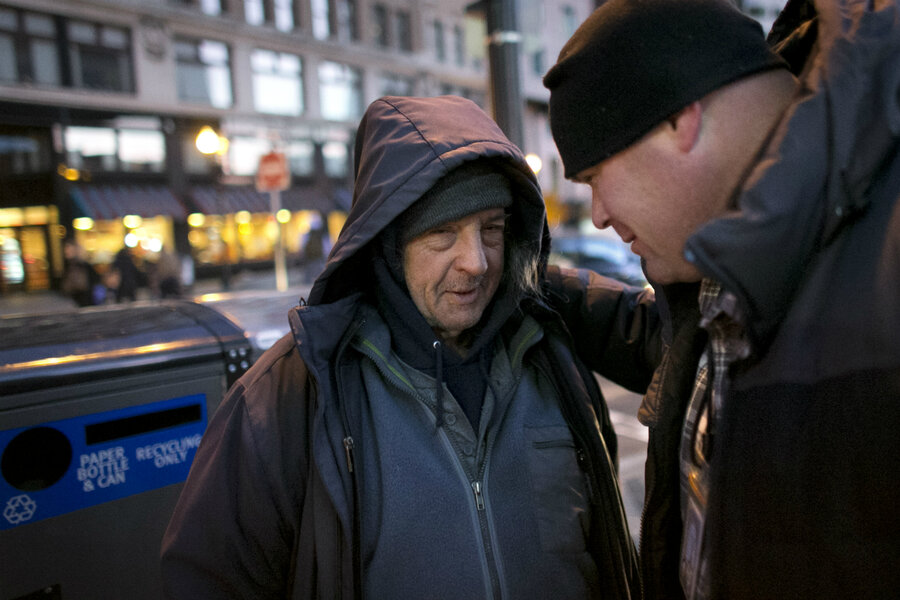US homelessness is on the decline
Homelessness has steadily decreased in the United States over the past decade. And one demographic particularly susceptible to homelessness – US veterans – has seen a particularly strong turnaround.
Since 2007, the overall number of homeless individuals decreased by 15 percent, while the number of homeless veterans decreased by more than 50 percent. The number of both unsheltered and sheltered homeless vets decreased sharply over the past nine years, with declines of more than 38 percent and 33 percent, respectively.
“[Since] George W. Bush there has been a federal strategic goal to end homelessness. And up until then, there has never been a federal effort to do that,” says Brian Sullivan, a spokesman for the US Department of Housing and Urban Development. “You are seeing the biggest declines in the veteran and chronic homeless subpopulations.”
Mr. Sullivan says that former President Barack Obama picked up where former President George W. Bush left off. “This is one of those nonpolitical, bipartisan things. Everybody gets it. ‘We’ve got to get these numbers down.’ Everyone agrees with that.”
“Opening Doors” was presented to Congress in June 2010 under Mr. Obama as the first comprehensive federal plan to end homelessness. “Housing First,” an approach that favors long-term housing solutions over emergency or temporary shelters, was an important component of this plan and it is largely responsible for today’s decreased rates, says Sullivan.
Rather than using incremental approaches, “If you place them in a house situation, and stabilize them with a roof over their head, then you see the numbers go down,” says Sullivan.
Progress has been especially marked in recent years. Between January 2015 and January 2016, the number of homeless veterans in the US decreased 17 percent. And as of July 12, 2017, more than 880 mayors, city officials, and governors had joined The Mayors Challenge to End Veteran Homelessness, a public commitment by local leaders to supply any veteran in need with housing. Three states – Delaware, Connecticut, and Virginia – and 47 communities have already achieved this goal.
“[T]he idea that anyone who has worn our country’s uniform spends their nights sleeping on the ground should horrify us,” said Ed Pawlowski, mayor of Allentown, Pa., when his city joined the list of communities with zero veteran homelessness in July. “Our veterans fought for our freedom and they deserve our help when they need it most.”
The problem varies from state to state. Half of the country’s 549,928 homeless individuals live in only five states: California, New York, Florida, Texas, and Washington. California, for example, is home to 12 percent of the nation’s population, but 28 percent of the US homeless population. Similarly, more than half of the country’s 39,471 homeless vets lived in these five states in 2016.
But even these five states have made progress in the fight against veteran homelessness. In 2010, there were almost 12,800 homeless veterans living in Los Angeles; New York City; Orlando, Fla.; Dallas; and Seattle. By 2016 this total had decreased to fewer than 4,500 individuals.
Eric Samuels, president and chief executive officer of the Texas Homeless Network, attributes a lot of his state’s success in addressing homelessness to progress made among the veteran population. In Texas the homeless population has fallen by almost 42 percent, or 16,666 individuals since 2007 – the second-largest decline in the country behind New Jersey – and veteran homelessness in the Lone Star State has decreased around 68 percent since 2009.
“More so than any other group, it’s veteran homelessness that has improved,” says Mr. Samuels. “Three of our biggest cities – Houston, Austin, and San Antonio – have ended veteran homelessness, bringing down the whole state average.”
The mayors of these cities used different strategies to reach this goal. Mayor Steve Adler of Austin, for example, brought “real estate people” to the table, and former Houston Mayor Annise Parker helped create “A Way Home,” an umbrella agency that coordinates the efforts of 35 local agencies. (Homelessness there is expected to rise in the aftermath of hurricane Harvey.)
“It’s not just the mayors,” says Samuels. “It takes nonprofits, the for-profit housing industry, faith communities – it’s a team effort. But when local leaders say it’s a priority ... that’s when big changes are made.”









